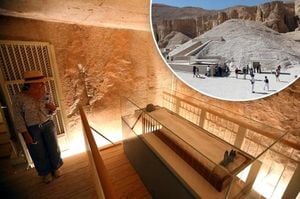On October 20, 2025, the East Wing of the White House became a construction zone, marking the first visible step in President Donald Trump’s ambitious $250 million plan to add a grand ballroom to the historic residence. The project, which Trump first announced back in July, has already stirred controversy, drawn criticism, and captured the attention of historians, architects, and political observers alike. With demolition crews tearing into the East Wing’s covered entryway and windows, the capital’s most storied address is, once again, at the center of a national debate about legacy, transparency, and the stewardship of American history.
The East Wing, built in 1902 and last significantly modified in 1942, has long served as the base of operations for the first lady and houses several important offices. According to CBC News, dramatic photos from the first day of demolition showed construction equipment ripping into the facade, with debris and metal cables strewn across the grounds. Reporters watched from nearby parks as the transformation began, while President Trump himself referenced the work during a White House event, telling guests, “We have a lot of construction going on, which you might hear periodically. It just started today.”
The ballroom, set to be the largest structural change to the White House since the Truman Balcony was added in 1948, is designed to be a sprawling 90,000-square-foot, glass-walled space. Trump has repeatedly stated that “presidents have wanted a ballroom for 150 years,” arguing that the current largest room, the East Room, is simply too small for grand state events. “It’ll be near it but not touching it, and pays total respect to the existing building, which I’m the biggest fan of,” Trump said in July, as reported by STV News. He emphasized that the new addition would not interfere with the mansion itself, a point he’s made more than once in both public statements and social media posts.
Yet, the project has not followed the usual channels of oversight and approval. The National Capital Planning Commission (NCPC), which typically reviews construction and major renovations to federal buildings in Washington, has not signed off on the ballroom. Will Scharf, the commission’s chair and also the White House staff secretary, explained at a September meeting that the agency “does not have jurisdiction over demolition or site preparation work for buildings on federal property. What we deal with is essentially construction, vertical build.” According to BBC News, it remains unclear whether the White House has submitted the ballroom plans for full agency review and approval. The White House itself has not responded to requests for comment, citing the ongoing government shutdown, and the commission’s offices are closed for the same reason.
Critics have been quick to voice concern over the lack of transparency and the speed with which the project is moving forward. Robert K Sutton, former chief historian of the National Park Service (NPS), told the BBC, “This building is so important. It’s considered, I think, to be the most important executive building in the world – yet we just don’t know what’s happening and I think that’s very inappropriate.” The NPS, which administers the White House and its parks, has a rigorous review process for construction projects, including vetting designs and costs. Sutton worries that this process is being bypassed and that the changes could reflect Trump’s personal style rather than the country’s historical legacy. “It’s always been called the People’s House,” he noted, underscoring the symbolic weight of any alteration.
Architectural groups have echoed these concerns. The Society of Architectural Historians, an international non-profit, issued a statement expressing “great concern over the proposed ballroom additions,” highlighting that this would be the first major change to the White House exterior in 83 years. The American Institute of Architects also called for a transparent and deliberate review, urging that “any further changes must proceed in a systematic manner that is rooted in a deep understanding of place and a thoughtful, deliberate design process.”
Despite the outcry, Trump and his administration have pressed on. White House press secretary Karoline Leavitt announced that East Wing offices would be temporarily relocated and the area would be modernized, promising “nothing will be torn down.” However, images and eyewitness reports from CBC News and BBC confirm that large portions of the entryway and windows have indeed been demolished, with the site now a hive of construction activity.
Funding for the ballroom is another source of intrigue. Trump has repeatedly claimed that the project will be built “with zero cost to the American Taxpayer! The White House Ballroom is being privately funded by many generous Patriots, Great American Companies, and, yours truly.” According to CBC News, the president even hosted a dinner for wealthy business executives who are supporting the project, including representatives from Lockheed Martin, Microsoft, Meta, Google, Amazon.com, and Palantir. Carrier Global Corp. has confirmed it is donating a world-class, energy-efficient HVAC system for the new ballroom, stating, “Carrier is honoured to provide the new iconic ballroom at the White House with a world-class, energy-efficient HVAC system, bringing comfort to distinguished guests and dignitaries in this historic setting for years to come.”
Still, the White House has yet to disclose the full list of donors, despite promises to do so. The lack of transparency has fueled suspicion and criticism from both political opponents and watchdog groups. Democratic Congresswoman Suzan DelBene, for example, took to social media to argue that the renovation illustrates Trump “cares more about himself than you,” tying the controversy to the ongoing government shutdown and broader debates over presidential priorities.
Construction is being managed by Clark Construction, with McCrery Architects overseeing the design. The Secret Service will provide necessary security enhancements and modifications, according to official statements. Jim McCrery, head of McCrery Architects, said, “I am honored that President Trump has entrusted me to help bring this beautiful and necessary renovation to The People’s House, while preserving the elegance of its classical design and historical importance.”
Plans call for the ballroom to be ready before Trump’s term ends in January 2029. The space, initially planned to seat 650, will now accommodate 999 people, making it the largest gathering space in the White House by far. The White House has released some architectural drawings, offering a glimpse of an opulent interior with gold chandeliers and seating for hundreds, but the full scope of the project remains somewhat shrouded in mystery.
Presidents have long left their mark on the White House, from Obama’s conversion of the tennis court for basketball to Nixon’s transformation of the indoor pool into the Press Room. Yet, as Robert K Sutton and others point out, changes to “the People’s House” are always fraught with controversy and symbolism. With the East Wing now under construction, the Trump ballroom project is set to become one of the most significant—and debated—alterations in the mansion’s storied history.
As the dust settles and the cranes continue their work, Americans and historians alike will be watching closely to see how this latest chapter in White House history unfolds—and what it will mean for future generations who call 1600 Pennsylvania Avenue home.




